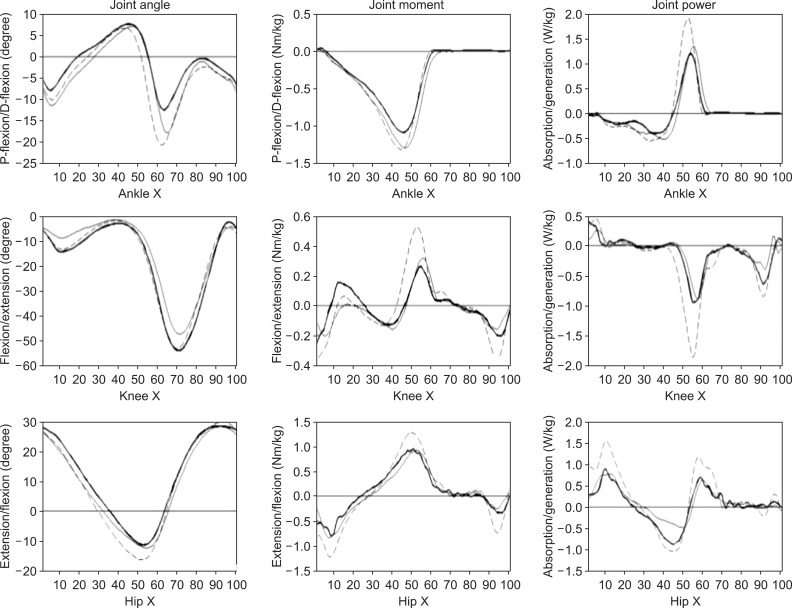Ann Rehabil Med.
2014 Feb;38(1):101-108. 10.5535/arm.2014.38.1.101.
Comparing Self-Selected Speed Walking of the Elderly With Self-Selected Slow, Moderate, and Fast Speed Walking of Young Adults
- Affiliations
-
- 1Department of Rehabilitation Medicine, Veterans Health Service Medical Center, Seoul, Korea. knox79@hanmail.net
- KMID: 2266547
- DOI: http://doi.org/10.5535/arm.2014.38.1.101
Abstract
OBJECTIVE
To find the characteristics of elderly gait, we compared the elderly walking at a moderate speed with the young adult walking at a slow, moderate, and fast speed.
METHODS
3D gait analysis was performed on 15 elderly and 15 young adults. Temporo-spatial, kinematic, and kinetic parameters were obtained. Self-selected moderate speed of the elderly walking was compared with self-selected varying speed of the young adults walking.
RESULTS
The elderly walked at slower speeds and had shorter step length, but showed similar cadences compared to the young adults. These results remained identical even after the normalization with height. The kinematic and the kinetic graph patterns did not show specific differences between the elderly and the young subjects. Ankle plantarflexion (APF) motion was prominently decreased in the elderly subjects. Hip flexion (HF) motion remained within similar range for the young adults'. HF moment and power were similar with the young adults', but APF power and hip extension power were decreased in the elderly subjects'.
CONCLUSION
A decreased APF motion and power were thought to be specific findings in the elderly walking. The preservation of HF motion and power could be considered a compensation mechanism or a modified neuromuscular pattern in the elderly. The characteristics of the elderly walking should be taken into account when planning rehabilitation strategies of elderly gait training and for future studies on the elderly population.
Figure
Reference
-
1. Prince F, Corriveau H, Hebert R, Winter DA. Gait in the elderly. Gait Posture. 1997; 5:128–135.
Article2. Bendall MJ, Bassey EJ, Pearson MB. Factors affecting walking speed of elderly people. Age Ageing. 1989; 18:327–332. PMID: 2603841.
Article3. Hamlin CR, Kohn RR. Determination of human chronological age by study of a collagen sample. Exp Gerontol. 1972; 7:377–379. PMID: 4345626.
Article4. Winter DA, Patla AE, Frank JS, Walt SE. Biomechanical walking pattern changes in the fit and healthy elderly. Phys Ther. 1990; 70:340–347. PMID: 2345777.
Article5. Kerrigan DC, Todd MK, Della Croce U, Lipsitz LA, Collins JJ. Biomechanical gait alterations independent of speed in the healthy elderly: evidence for specific limiting impairments. Arch Phys Med Rehabil. 1998; 79:317–322. PMID: 9523785.
Article6. DeVita P, Hortobagyi T. Age causes a redistribution of joint torques and powers during gait. J Appl Physiol (1985). 2000; 88:1804–1811. PMID: 10797145.7. Riley PO, DellaCroce U, Kerrigan DC. Effect of age on lower extremity joint moment contributions to gait speed. Gait Posture. 2001; 14:264–270. PMID: 11600330.
Article8. McGibbon CA. Toward a better understanding of gait changes with age and disablement: neuromuscular adaptation. Exerc Sport Sci Rev. 2003; 31:102–108. PMID: 12715975.
Article9. Elble RJ, Thomas SS, Higgins C, Colliver J. Stride-dependent changes in gait of older people. J Neurol. 1991; 238:1–5. PMID: 2030366.
Article10. Lelas JL, Merriman GJ, Riley PO, Kerrigan DC. Predicting peak kinematic and kinetic parameters from gait speed. Gait Posture. 2003; 17:106–112. PMID: 12633769.
Article11. Kim DY, Park CI, Choi YS, Moon JY, Lim JY, Kim DY, et al. Effect of slow walking speed on gait. J Korean Acad Rehabil Med. 2007; 31:317–323.12. Astephen Wilson JL. Challenges in dealing with walking speed in knee osteoarthritis gait analyses. Clin Biomech (Bristol, Avon). 2012; 27:210–212.
Article13. Judge JO, Davis RB 3rd, Ounpuu S. Step length reductions in advanced age: the role of ankle and hip kinetics. J Gerontol A Biol Sci Med Sci. 1996; 51:M303–M312. PMID: 8914503.14. Kwon DY, Sung IY, You JY, Ha SB. 3-Dimensional gait analysis of Korean adults. J Korean Acad Rehabil Med. 1998; 22:1107–1113.15. Lim W, Ryu T, Choi H, Choi HS, Chung MK. A comparison of gait characteristics between Korean and Western young people. J Ergon Soc Korea. 2006; 25:33–41.16. Cho SH, Park JM, Kwon OY. Gender differences in three dimensional gait analysis data from 98 healthy Korean adults. Clin Biomech (Bristol, Avon). 2004; 19:145–152.
Article
- Full Text Links
- Actions
-
Cited
- CITED
-
- Close
- Share
- Similar articles
-
- Effect of Slow Walking Speed on Gait
- Effects of Walking Exercise Intensities on Fatigue, Serum Lipids and Immune Function among Middle-Aged Women
- Association between Toe Pressure Strength in the Standing Position and Maximum Walking Speed in Older Adults
- Effects of Plastic Ankle-Foot Orhtosis on Hemiplegic Ambulation
- Effects of Asymmetrical Weight Bearing during Straight and Circular Walking in Hemiplegic Patients


